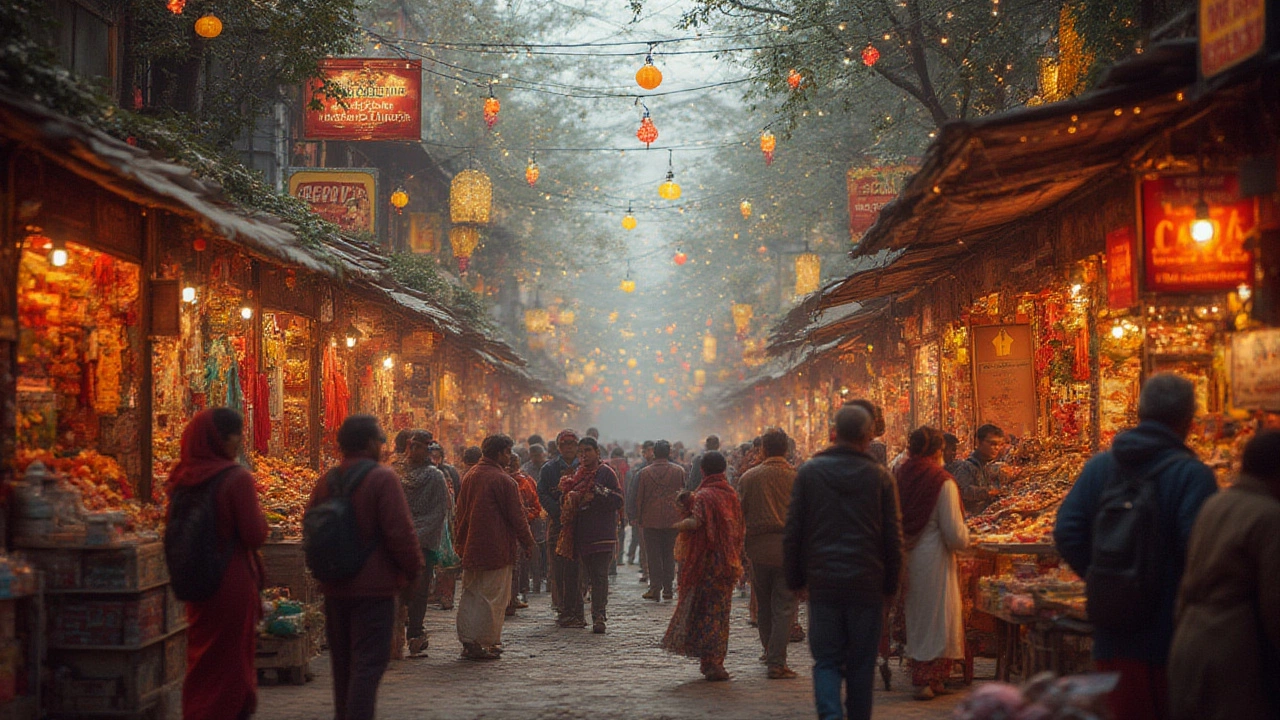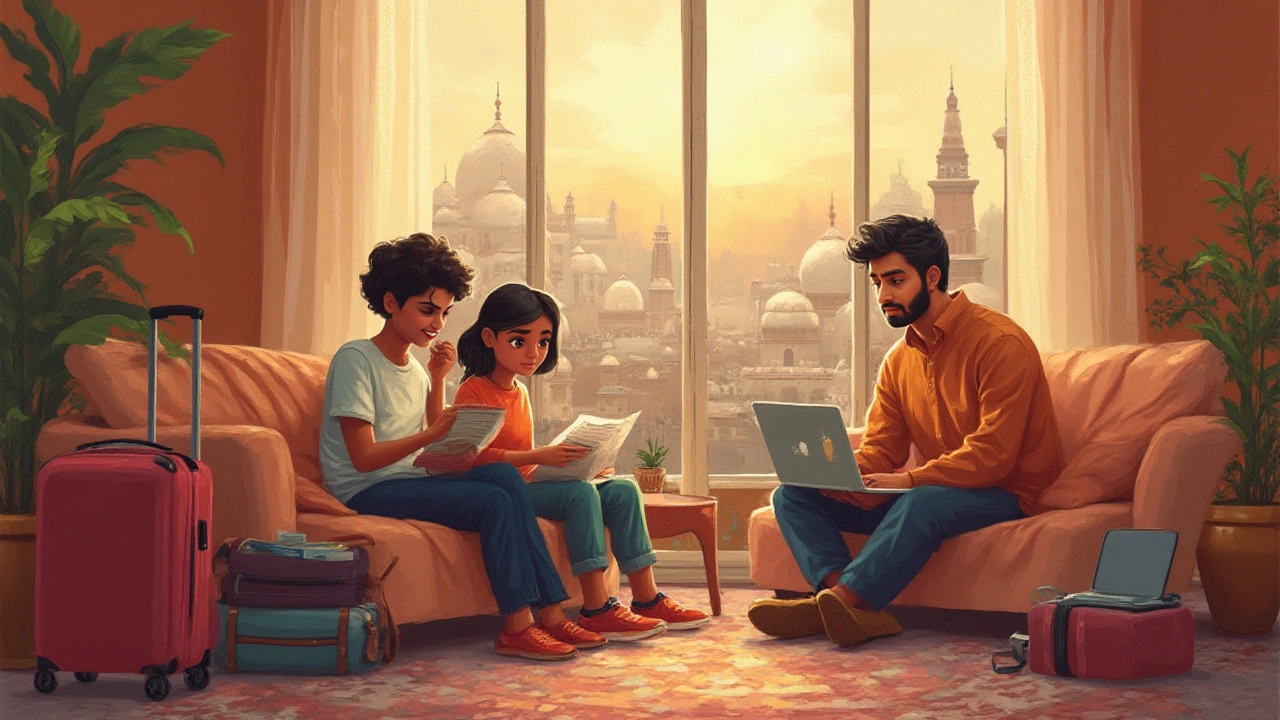Most Expensive Time to Visit India: High Season Costs & Insider Tips
 Jul, 12 2025
Jul, 12 2025
Picture this—you’re hunting for flights, eager to chase India’s ancient wonders and wild colors, when sticker shock smacks you right in the face. December hits, and suddenly, prices jump so steep they're almost comical. Out of all twelve months, December stands tall as the priciest time to see India, and not by a close margin. Wondering why everyone wants a slice of the subcontinent under the cool winter sun and why it might hit your wallet harder than you’d think? Let’s get to the heart of it.
Why December Skyrockets: The High Season Breakdown
It might sound odd if you’re picturing snow drifts and frosty mornings, but December in India is when the weather is at its finest. The north wakes from its sticky sleep and leopard-print sweaters make more sense than perspiration-wicking tees. In Goa, Rajasthan, Kerala, and pretty much anywhere that’s ever made your ‘places to go’ list, the air is just right—not too humid, not too hot. This is the cue for international and domestic travelers alike to pour in. Christmas and New Year’s add jet fuel to the demand. Families on winter break, expats returning home, luxury trippers escaping gray European winters—everyone tries to snag a slice of the magic during this window. That’s supply versus demand 101: prices for everything go up.
Trying to book a hotel in Goa after the first week of December? Good luck getting a deal. Even budget stays triple their rates. Top-end resorts need you to book months in advance—sometimes a full year. This isn’t just about foreign visitors. Indian domestic tourism has exploded in the last decade. During 2023, more than 240 million tourist visits were recorded in December alone (per India’s Ministry of Tourism stats). Heritage sites like Jaipur’s forts and Agra’s Taj Mahal see crowds matching Mumbai’s local trains at rush hour.
And it doesn’t stop with hotels. Flight tickets climb steepest from mid-December all the way through the first week of January. Domestic airlines like IndiGo and Air India routinely bump up base fares by as much as 70%. International routes—say, New York to Delhi or London to Mumbai—see some round-trip fares more than double. Say you usually pay $800; expect $1,600 or more if you even find seats. Even luxury trains like the Maharajas’ Express or Palace on Wheels are packed and command eyewatering rates this month.
Why else does December peak so much? Wedding season. Many Indian families prefer winter for grand marriages when outfits are comfortable and outdoor venues sparkle under cool skies. This brings in extended families, decorators, and plenty of local travelers who snap up hotel blocks, push up demand, and congest city roads. By mid-month, the boom is inescapable—fleets of rental cars gone, taxis unavailable, and even last-minute train tickets vanishing faster than you can refresh the IRCTC app.
Goa holds legendary New Year’s parties that draw crowds from Russia, Israel, and pretty much every city in India. Music festivals, pop-up restaurants, and LGBTQ-friendly beach raves all mean one thing: you’ll pay premium for the privilege. Even bike and scooter rentals hit $50 a day, food shacks double menu prices, and beach huts are booked out unless you’re ready to splurge.
This boom isn’t restricted only to usual tourist haunts. Even Himalayan hill stations like Shimla, Manali, and Darjeeling get overrun. Many are after the novelty of snow—the rare white Christmas for selfie hunters and kids who’ve never seen flakes before. Even ayurvedic resorts in Kerala, and yoga ashrams in Rishikesh that are whisper-quiet in off-season, fill up beyond capacity in December. You can see it right on Google Trends and trip review forums: December is an India-wide jackpot for hotels, airlines, and anyone who rents a bed, a vehicle, or a boat.
You might spot some really crazy rates if you check booking sites around big events. A simple search for “Goa hotels December 28 - January 2” throws up $400 a night offers for bungalows that cost $70 in July. And airline price-tracking tools (Hopper, Skyscanner, Google Flights) consistently clock December’s spikes far above any other month. Even seeing a Bollywood star in a Mumbai club can't compare to the collective urge to travel in December.
Here’s something concrete. This table gives you an idea of just how sharp the jump is:
| Item | Off-Season (July) | Peak Season (December) |
|---|---|---|
| Delhi-Goa Return Flight | $90–$120 | $220–$350 |
| Mid-Range Kolkata Hotel | $35–$55/night | $75–$120/night |
| Goa Beach Hut | $25/night | $120–$250/night |
| Day-Tour Rate | $20–$28 | $45–$65 |
| Luxury Train Berth | $600/Night | $1200–$1500/Night |
If you love numbers, last year the Indian Association of Tour Operators reported international bookings up by 54% in December compared to July. The message? December is when tourism goes wild—in price, in crowds, and in spectacle.

How Prices Change: What to Expect for Hotels, Flights, and Activities
High season isn’t just about slightly higher rates—it’s a giant leap. When you search for accommodations, you’ll notice something funny on booking sites: properties listed as “50% sold out!” two months in advance. In reality, many hotels and popular hostels upload only the most expensive rooms first. Cheaper options get snapped up or simply are not available. This intentionally drives the price ceiling upward as the dates draw closer. Sensing the escalating demand, some places literally change their rates daily.
If you have visions of spontaneous backpacking, December might not be for you. Walk-in hotel deals all but vanish. Even OTAs like Booking.com and Agoda show “last room left!” warnings which, unfortunately, are mostly accurate. Cancellations turn to gold for those watching the sites like hawks. Booking early (four to six months out) is absolutely key for any hope of normal pricing in prime destinations. But even then, expect a premium; discounts are unicorns in December.
Next up: flights. Whether it’s AirAsia, Vistara, Emirates, or local no-frills brands, the earlier you book, the less you pay. If you pick international arrivals like Christmas Eve or New Year’s Day, expect airport chaos in addition to dizzying prices. Airlines know they have a captive audience. Unlike off-season periods—when flash sales and coupon codes make flying feel like a game show—high season travelers pay sticker price or worse. Even train tickets on India's sprawling rail network go up. Premier trains, such as Rajdhani and Shatabdi, are booked out right when bookings open, and India’s ‘Tatkal’ urgent ticket system sees fares 20-30% above regular rates.
Tours and guided excursions aren’t immune. A camel safari in Jaisalmer or backwater cruise in Kerala could cost twice what you’d pay in September. Foreign travelers often pay a hidden premium: some experiences maintain separate offline rates for locals and foreigners, which gets especially obvious at UNESCO sites. Indian nationals might pay 50–100 rupees, while international visitors swipe for 600–1200 rupees. That gap only widens when there’s peak season demand.
Thing is, some costs can sneak up: local taxis and rickshaw drivers in tourist towns turn rates into full-fledged auctions. Uber and Ola surge pricing kicks in, sometimes tripling what you’d pay for the exact same ride two months earlier. Popular Uber routes between South Goa and Palolem, for instance, go as high as $40 for a forty-minute drive. Buses are often full, and car rental agencies practically have a field day.
Looking for fun nightlife in Mumbai or Delhi? Club and bar entry fees soar, as do guest DJ gigs—anything glittery or exclusive seems to cost 2–3x more. Restaurant reservations are necessary in foodie cities like Bengaluru and Kochi, and you’ll wait in lines for street snacks even in modest markets. India’s best-known music festivals, like Sunburn (Goa) or Magnetic Fields (Rajasthan), happen in December. Early bird tickets are gone by July, and at-the-gate prices can surpass $300 per head for multi-day passes.
Even less touristy regions aren’t safe from the price crush. Think quiet Kumaon towns in Uttarakhand or sleepy Hampi ruins in Karnataka; everywhere popular faces a supply squeeze. Private guides, eco-tours, and even yoga teachers offer little or no wiggle room—either you pay the full fare or miss out. Demand means power, and the power flips away from the traveler.
Let’s not forget souvenirs and shopping. Vendors in Old Delhi’s Chandni Chowk, Jaipur’s bazaars, and Mumbai’s luxury malls know exactly when tourists descend, and prices edge up. Bargaining is still possible, but the starting point is far higher than mid-year when there’s less foot traffic.
Practical tip: Indian credit cards and payment apps come with special discounts and cashback offers, but most international tourist cards will miss out. Carrying cash helps—but beware ATM lines, which are real in high season. Even finding a free table in popular cafes, like in Leh or Pondicherry, is more of a lottery than a guarantee. Spontaneity takes a backseat to careful planning, and less glamorous areas see their own version of the December rush.
Accommodation hacks? Sometimes, family-run homestays or lesser-known B&Bs don’t hike prices as aggressively—if you can find them early. Camping remains the only truly price-stable option, although you’ll sacrifice comfort and a hot shower for the savings. Think hard about which luxuries you’re willing to let go for a shot at peak season India vibes.
If you’re intrigued by numbers, here’s another data point: the December hotel occupancy rate in major Indian tourist cities generally exceeds 95%. Compared to July’s 50–55%, it’s a landslide. As with flights, last-minute hotel dotcom deals are mostly myth. Your best bet for a bargain is booking as soon as summer starts or hunting around in less-frequented neighborhoods. The good stuff vanishes early.

Insider Ways to Avoid Massive December Costs
Okay, so you’re sold on seeing India’s winter magic, crowds and all, but want to avoid draining your bank account for every meal, flight, or hostel bunk. Is there a secret? Actually, a few—if you’re willing to bend a bit on comfort or get clever with planning.
First, try skirting the most popular destinations. While Rajasthan’s Jaipur, Udaipur, and Jaisalmer are jammed, less-traveled towns like Bundi, Chittorgarh, or Alwar offer a taste of royal architecture and charm at a fraction of the cost. South India’s Kodaikanal, less famous than Ooty or Munnar, is fresher—and way more affordable when demand peaks. Even near Goa, head to Gokarna or Varkala in Kerala for stunning beaches but fewer crowds and better rates. Instead of party capital North Goa, the far South (like Agonda or Patnem) stays relatively sane until Christmas week.
Second, fly smart: Use the “multi-city” search options to string together lesser-used airports. Major hubs—Delhi, Mumbai, Bengaluru—see prices soar, but flying into smaller places like Kochi or Ahmedabad, then connecting via road or train, often saves a surprising chunk. Set flight alerts in late summer, and when deals pop up, grab them—waiting usually means missing out.
For trains, book right as the reservation window opens—120 days ahead for Indian Railways. Foreigners can tap the International Tourist Quota, which reserves a few seats on major trains, but you have to be early. If you miss out, state-run buses and private Volvo sleeper coaches provide budget options—but also fill fast in December.
Stay flexible with your itinerary. Cutting New Year’s week out (December 24–January 2) drops hotel and flight costs by up to 30%. Visiting in early December or after January 7 lands you in the sweet spot—good weather, fewer people, normal prices. Ditch city centers for neighborhood hotels, guesthouses, or serviced apartments; many locals rent out rooms (check platforms like Airbnb, Homestay, or MakeMyTrip). Traveling with friends? Take a whole flat, which slices per-person rates, and adds a kitchen for prepping meals to spare your wallet from constant restaurant spending.
Activities? Opt for government-subsidized or local-run tours rather than international operators. The difference in price can be dramatic. For example, a Taj Mahal sunrise tour with a Delhi travel agency can be $80–$100, while a local Agra guide asks $15 for the same walk—just with less polish and more honest stories. Skip premium yoga resorts for public classes. Temple festivals, cultural fairs, and flea markets are usually free and peak in December, so you don’t miss out on vibe just because you’re thrifty.
Always, always negotiate. Shopkeepers expect it, taxi drivers assume it, and even some hotel managers will play ball for direct cash payments if you’re staying a few nights. A friendly chat might get you airport transfers or a free meal thrown in—never hurts to ask. Avoid using ATMs in tourist hotbeds and hit up banks or markets where there’s less pressure. Carry small bills, as many vendors can’t break big notes and may use that as a reason for inflated prices.
Don’t fall for the FOMO social media hype—luxury is nice, but India’s magic is in its chaos, energy, and surprises. Some of the best food you’ll have will be from a hole-in-the-wall or roadside stand, not a five-star rooftop. Wander off the main drag, explore dusty alleys in Gujarat or Andhra Pradesh, and you’ll not just dodge crowds but also keep your expenses in check.
Here’s a final practical nugget: most expensive month India searches spike in September on travel sites, right as people finalize winter plans. If you want specific hot spots, try booking as soon as you see those searches picking up—use Google Trends as your radar. If you thrive on adventure, shift your dates or your route and you’ll see India shorn of tourist adrenaline but rich in real-life color, scent, and noise. And if you’re set on the spectacle, remember—every rupee extra buys you stories nobody else can tell.